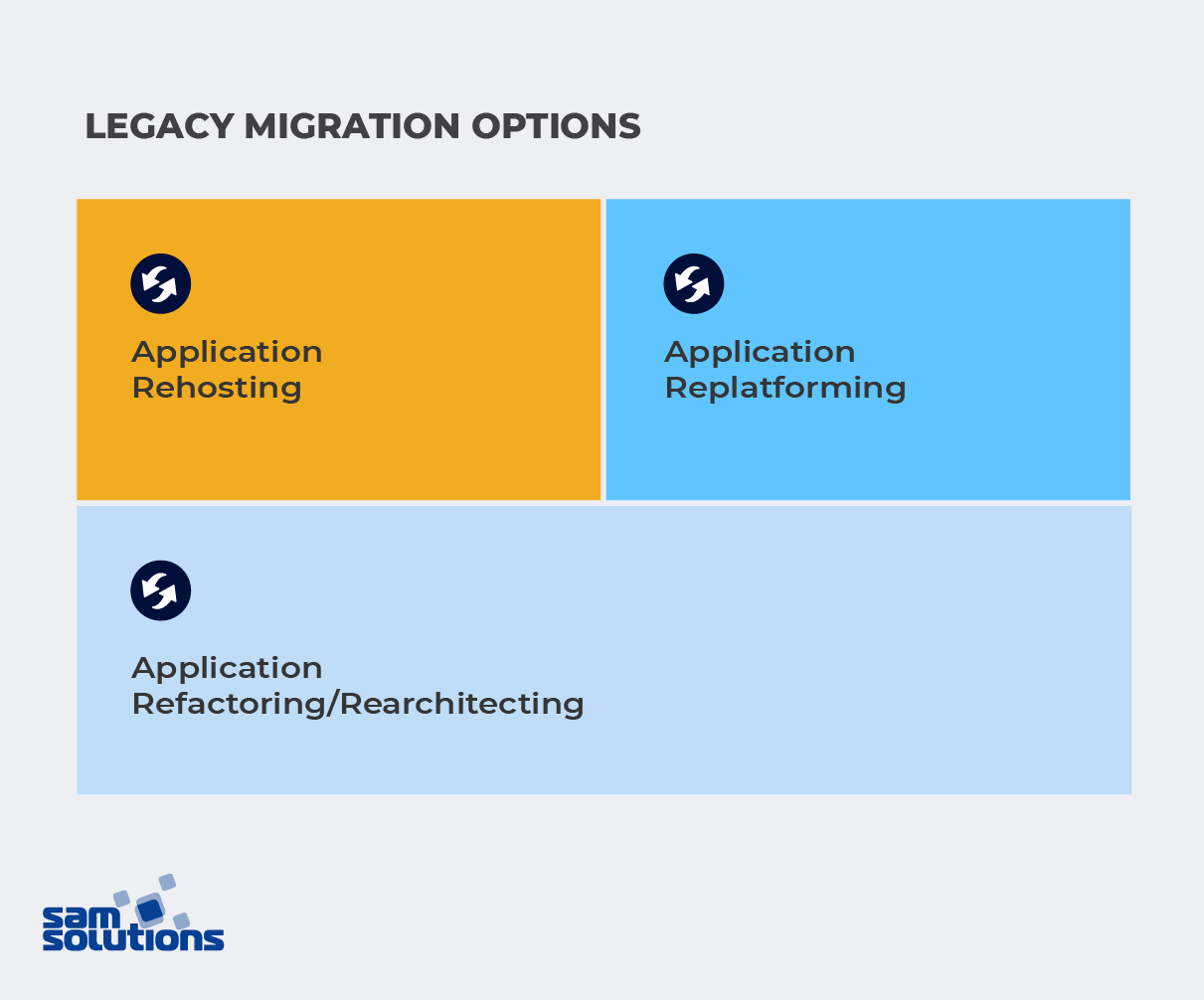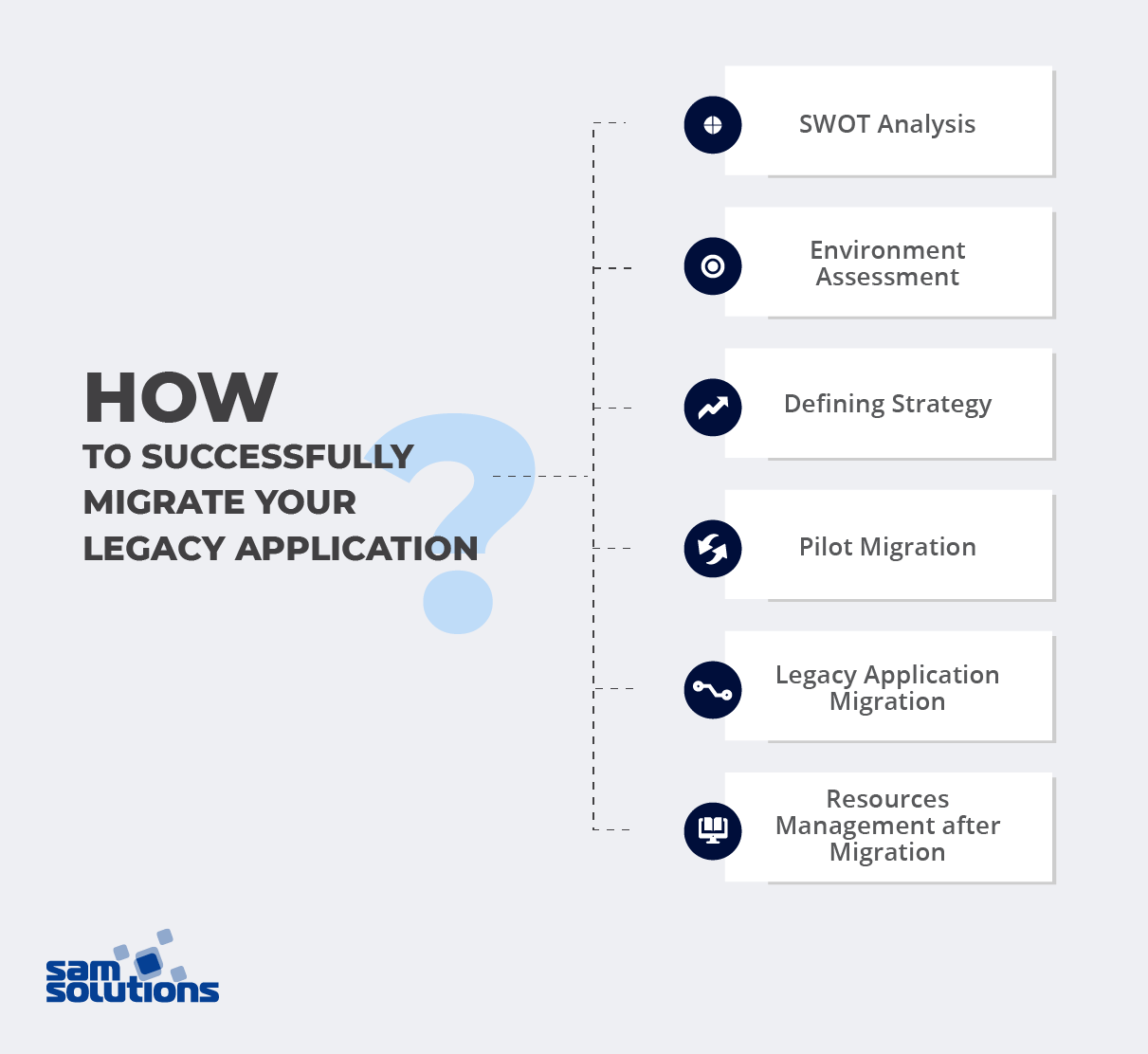Outdated software may continue to serve its main purposes and cater to the clients’ specific needs, but in reality, it is a tinderbox waiting to explode. Read on to know more about legacy migration.
What Is Legacy Migration?
Legacy systems are applications, programs, or hardware that continue to be used despite their advanced age. They are often obsolete, and ongoing use of these systems can delay the business upgrade and enhancement.
Legacy programs can in fact pose a threat to the company’s security and workflow efficiency.
Legacy application migration services refer to the process of transferring or upgrading existing software applications and systems to newer technologies, platforms, or architectures.
It is not easy for businesses to make a thoughtful technical plan on changing outdated applications and software platforms to welcome innovation and transformation of their IT processes, which is why a comprehensive approach is imperative.
Why Should My Business Migrate?
It is easy to list the reasons for legacy application migration, as there is a bounty of advantages this change can introduce. First of all, it significantly boosts the productivity of your enterprise and the quality of your work, which can help you stand out among the competitors in your business domain. Further, old-fashioned software is incompatible with new systems, so if you continue using it, multiple issues will arise, such as malfunctioning, cybercriminal attacks due to poor security features, expensive support and maintenance services, and lack of available updates. That’s why it is imperative to migrate legacy software.
The migration procedure should not interrupt company processes, so it’s vital to choose the approach with minimal intervention in the system. Currently, the following migration options are possible: lift-and-shift and transformation. The former is the transfer of the app along with all the stored information to the cloud, with no application redesign. This approach is often chosen by software engineers when the system fails to function properly, becomes outdated, or a more advanced technology emerges.
The latter type mainly refers to cases, when the organization’s politics is remodeled, or when the legacy software no longer facilitates business ventures or satisfies customer demand. Timely legacy application migration services help companies to be in sync with the latest technologies, address all the technical challenges and ensure the ultimate UX to the clients.
Leverage SaM Solutions’ decades-long expertise in Legacy Application Migration to create top-notch solutions for your business.
Why Adopt the Cloud?
There are numerous reasons why it is a wise decision to utilize cloud technologies. Here are the most widespread ones:
- Cutting costs
The most alluring reason is driving down costs. No need to spend money on storage space and buy expensive programs. A lot of applications are on the cloud services for free usage, and you can add others only when needed. The problem of cost savings is especially significant for small companies, enterprises with limited budgets, and startups.
- Ease of use
All you need to do is set up the cloud technology and enjoy it, no need for time-consuming downloading and installation. With almost unlimited data storage capacity and remote access, it enhances the workflow and collaboration in the company.
- Availability of additional storage
In comparison with regular hard drives and servers, the cloud provides an opportunity to store more data.
- Automation
No need to feel anxious about updating your service – the cloud syncs with the most recent versions automatically.
- Flexible agile working process
Cloud ensures better coordination of collaborative efforts in real time. Your team can view and edit the same files simultaneously from different locations and multiple devices without the need to be physically present in the office.
- Scalable technology
Companies can scale the cloud easily if they need more space for data storage. Similarly, if they need less space, they can change their storage limits and switch to a less expensive plan.
- Increased data security
All employees, regardless of their whereabouts, can access the stored information securely thanks to strict confidentiality policies and permission-based rules.
Why Don’t More Companies Migrate Legacy Applications?
Legacy programs and technologies may seem safe and reliable since they have proved to be of use for so many years. Nevertheless, in most cases, this is a delusion. Moving forward with new solutions always requires a lot of courage, but improvements are generally huge.
Do not be afraid of trying new approaches and testing new ideas, as they are more likely to bring a lot of benefits to your daily work routine than holding on to the old ways. But every company is unique and it is important not to overlook the peculiarities of your organization while migrating to new business applications.
Why Do So Many Legacy Migrations Fail?
Often companies run into financial losses when their migration process is interrupted and fails. Migration failures occur because of a lack of proper strategy and the inability of applications to correctly restart in the cloud. Disruptions during the migrating process pose threats to the efficient work of the organization, its stability, income, and good repute.
Given there are so many risks in migration, business owners should be careful when choosing the software company they partner with. With profound expertise and in-depth knowledge of cloud technologies, good software experts are able to make sure that the migration goes smoothly and without any technical issues.
What Are Legacy Migration Options?

Application Rehosting
In this case, the legacy applications are transferred to the cloud or modern infrastructure without making significant changes to the application itself. It is a fast and comparatively simple way to migrate the system. The drawback of this variant is that it does not have many cloud-oriented advantages and does not leverage the full potential of modern architectures. However, it is optimal when a company’s aim is to guarantee access to their app from any location on the globe, when the consumption of hardware resources needs optimization.
Application Replatforming
Replatforming option means migrating legacy applications to a new platform or infrastructure with certain changes to the code and architecture. It enables leveraging modern capabilities, resulting in improved performance, efficiency, and additional features. It usually requires more effort than rehosting but offers significant benefits in terms of technology utilization and ensure compatibility with the specific requirements of the platform.
Refactoring / Rearchitecting
This type of legacy application migration involves redesigning the system architecture to improve scalability, increase performance, to address limitations, and adapt to new requirements. This approach may involve adopting microservices, service-oriented architecture (SOA), or other modern architectural patterns. However, this method requires more skilled professionals, and more financial and time investment in comparison with the previous options.
Mixed or Hybrid Approach
A hybrid approach combines multiple migration options based on different components or modules of the legacy system. It allows organizations to leverage the benefits of different strategies, taking into account factors such as criticality, complexity, and cost-effectiveness of each component.
How to Successfully Migrate Your Legacy Application?

SWOT Analysis
It is extremely beneficial to conduct a SWOT analysis prior to any other actions during the legacy application migration process. This tool allows comprehensive investigation of your project by looking at the following aspects:
- Strengths. You can define what unique resources and capabilities you can use in the project. Strengths may include:
- Expertise and experience in legacy application modernization.
- Skilled team with knowledge of both legacy systems and modern technologies.
- Established methodologies and best practices for application migration.
- Access to tools or frameworks that facilitate the migration process.
- Strong relationships with technology partners or vendors.
- Weaknesses. These are internal factors that can hinder or pose challenges to the legacy application migration. Weaknesses may include:
- Limited resources or budget constraints for the migration project.
- Insufficient documentation or outdated documentation about the legacy system.
- Resistance to change or reluctance from stakeholders to embrace modernization.
- Potential disruptions to business operations during the migration process.
- Lack of in-depth understanding of the legacy application architecture and dependencies.
- Opportunities. Discover how you can take advantage of the instruments and resources you have, and how your strong points can benefit the process. Opportunities may include:
- Market demand for modernized applications and the potential to gain a competitive advantage.
- Integration with emerging technologies such as artificial intelligence, machine learning, or Internet of Things (IoT).
- The availability of modern technologies, platforms, and solutions that can enhance the legacy system’s performance and scalability.
- Cost savings and efficiency gains by migrating to cloud-based solutions or adopting microservices architecture.
- Access to a larger talent pool or resources for consulting, implementation, maintaining and supporting modernized applications.
- Threats. Find out what can hurt your efforts and disrupt the success of the migration process, and how your weak points can influence the outcomes of the project. Threats may include:
- Potential data loss or data integrity issues during the migration process.
- Security vulnerabilities or risks associated with the modernized application.
- Increased competition or market disruption during the migration period.
- Regulatory compliance requirements that need to be considered during the migration.
- Incompatibility or limitations of third-party systems or services that the application relies on.
By conducting a SWOT analysis specific to legacy application migration, organizations can identify the key factors that influence the migration project’s success and develop strategies accordingly.
Please feel free to contact us if you have any inquiries or ensure that your team possesses the required expertise to effectively perform the following services:
Assessment and Planning
This involves a detailed evaluation of the existing legacy application, its architecture, codebase, dependencies, and business requirements. The migration team analyzes the feasibility of migration, identifies risks, defines migration goals, system performance, resilience requirements and develops a migration roadmap.
Platform and Technology Selection
Based on the assessment, the migration team determines the most suitable target platform and technology stack for the modernized application. This may involve selecting operation system, cloud platforms and services, containerization solutions, architecture, or other modern frameworks and tools.
Defining Strategy and Selecting Services
There are several migration options (described above) and services to choose from:
- Custom Development. This approach involves rebuilding the legacy system from scratch using modern development practices and technologies. It provides the highest level of flexibility, as the new system can be tailored to specific business needs and requirements. Custom development allows for the incorporation of new features, enhanced user experiences, and improved performance.
- Platform-Based Development. Instead of starting from scratch, this approach involves leveraging a pre-built platform or framework to develop the new system. These platforms offer a foundation with a range of functionalities, modules, and components that can be customized and extended to meet specific business requirements. Platform-based development can significantly reduce development time and effort, as it provides a solid base to build upon, but customization may be limited or requires too much custom development.
- Data Migration. Legacy applications typically store a significant amount of data that needs to be migrated to the new system. This involves analyzing the data structure, creating and mapping it to the new schema, and developing strategies for data extraction, transformation, and loading (ETL). Data migration ensures that valuable information is retained and accessible in the modernized application.
- Integration and Interoperability. Many legacy applications have dependencies on other systems, databases, or third-party services. During migration, it is crucial to ensure seamless integration and interoperability with these external components. This may involve developing APIs, connectors, or adapting interfaces to maintain compatibility and functionality.
- DevOps. The incorporation of DevOps practices throughout the migration process is essential. DevOps promotes collaboration and integration between development and operations teams, enabling continuous integration, continuous delivery, and faster deployment cycles. By implementing DevOps principles, organizations can enhance efficiency, streamline workflows, and ensure smoother transitions during the legacy application migration process, resulting in improved outcomes and reduced time to market.
- Quality Assurance (QA) and Testing. QA and testing are paramount in the migration of a legacy application. The software QA process encompasses various methodologies, standards, technologies, automation frameworks and tools, along with diverse testing types. Testing services, including unit testing, integration testing, system testing, and performance testing, is conducted to verify the functionality, reliability, and security of the modernized application. Thorough QA and testing are crucial as they help identify and rectify potential issues such as bugs, vulnerabilities, or performance shortcomings. This ensures the development of a high-quality and robust modernized application. Learn more about our QA and testing offerings.
To make the right choice, it’s crucial to consider important factors such as the specific requirements of your business and customers, as well as timing and budgetary constraints. Keep in mind that certain options may introduce challenges during the migration process and incur additional costs. The best advice here is to rely on a team of experienced consultants, architects, and top-notch developers.
Pilot Migration and Go-Live
To prepare for the actual migration, it is recommended to run a pilot test. It can take quite some time, but eventually, it will help avert the risks that may arise during the actual migration. Once the modernized application passes all the testing phases, it is deployed to the production environment. The deployment process involves configuring the infrastructure, setting up monitoring and logging mechanisms, and performing a smooth cutover from the legacy system to the modernized application.
Post-Migration Support
After the migration, ongoing monitoring, testing, support and maintenance are provided to address any issues, optimize performance, and ensure the stability of the modernized application. Regular updates, bug fixes, and security patches are delivered to keep the application up to date and aligned with evolving business needs.
Don’t let outdated systems slow down your business! Our Legacy Application Migration experts are just a click away.
What Does SaM Solutions Offer?
Legacy application migration is a challenging process that requires comprehensive understanding and deep expertise in software development. To avoid the risks of errors and malfunctions, make sure you consult a well-established software services provider for this transition.
SaM Solutions will be happy to provide services of legacy application migration to Linux, and cloud technologies, which can help you boost your company’s infrastructure and make internal processes more efficient. For example, migration to Linux may be of use, if Windows doesn’t support low-level requests that are needed for the devices, and it is possible to implement Linux at a lesser cost.
Our team consists of experienced software engineers who would be glad to help you with your digital modernization. We genuinely value IT evolution with the ultimate aim to help you streamline business processes, secure confidential data, increase productivity and gain more recognition.



















![Web App Development Cost in 2025 [Key Price Factors]](https://www.sam-solutions.com/blog/wp-content/uploads/fly-images/31797/Web-App-Development-Cost-cover@2x-370x238.webp)










